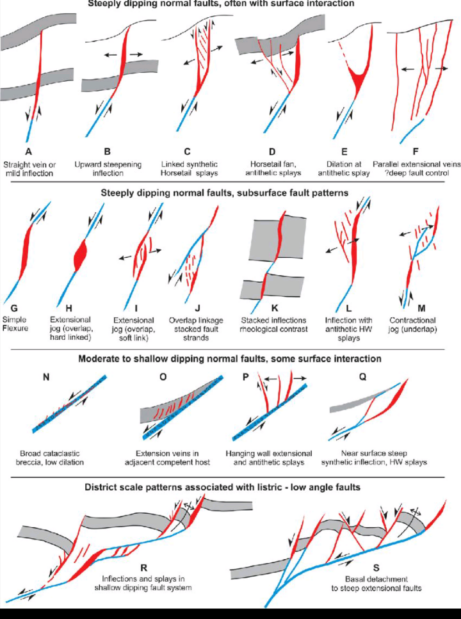Introduction
Structural control is one of the most significant factors influencing the formation and distribution of hydrothermal gold deposits. Structural geology determines the pathways for mineralizing fluids, the locations of ore deposition, and the overall geometry of gold-bearing zones. Understanding these structural controls is essential for exploration geologists seeking new gold deposits and for mining operations aiming to maximize resource extraction.
In hydrothermal systems, gold is transported in solution by hot, mineral-rich fluids that circulate through the Earth’s crust. The deposition of gold occurs when these fluids interact with favorable structural settings, leading to changes in temperature, pressure, or chemistry. Therefore, structures such as faults, shear zones, fractures, and folds play a crucial role in the concentration of gold.

Structural Controls in Hydrothermal Gold Deposits
1. Faults and Fractures as Fluid Pathways
Faults and fractures are primary conduits for hydrothermal fluids. These structural features create zones of increased permeability, allowing mineral-rich fluids to migrate from deep sources to shallow crustal levels, where they can deposit gold. The movement and reactivation of these structures also contribute to repeated episodes of fluid flow and mineralization.
- Normal Faults – These extensional structures create open spaces where hydrothermal fluids can circulate. The hanging wall and footwall of normal faults may contain mineralized zones if they have undergone multiple episodes of movement and fluid flow.
- Reverse and Thrust Faults – In compressional settings, reverse faults and thrust faults create high-pressure environments that can lead to fluid overpressure and subsequent gold precipitation. The interaction between thrust faults and host rocks often produces breccia zones that enhance permeability.
- Strike-Slip Faults – These faults generate secondary structures such as extensional fractures, fault jogs, and Riedel shears, which become ideal sites for hydrothermal gold deposition. The periodic reactivation of strike-slip faults results in pulsed fluid movement and ore formation.
2. Shear Zones and Deformation Patterns
Shear zones are major structural features associated with large-scale hydrothermal gold deposits. These zones of intense deformation form due to tectonic forces and serve as long-lived pathways for hydrothermal fluids. The interaction between shear zones and host rocks enhances gold precipitation through mechanical and chemical processes.
- Ductile Shear Zones – These zones accommodate deformation through plastic flow and often host gold-bearing quartz veins. The gradual accumulation of strain results in permeability variations, allowing mineralization to occur in specific structural domains.
- Brittle-Ductile Transition Zones – Many gold deposits form in regions where rocks experience both brittle and ductile deformation. In these areas, gold mineralization is concentrated along faults and fractures within shear zones, particularly where competency contrasts exist between different rock types.
3. Folds and Associated Structures
Folds influence hydrothermal fluid flow and gold deposition by creating structural traps and permeability contrasts. The geometry of folds controls the distribution of mineralization in different ways:
- Anticlines – These upward-arching structures create zones of compression, which can lead to the development of fractures and faults that act as conduits for hydrothermal fluids. Gold is often concentrated in fold hinges, where fluid flow is focused.
- Synclines – These downward-folded structures may also host gold deposits, especially when associated with faults or permeable lithologies that act as fluid reservoirs.
- Axial Planar Fractures – The planes of weakness along folded rocks provide secondary pathways for hydrothermal fluids, contributing to gold precipitation.
4. Breccia Zones and Permeability Contrasts
Breccia zones, formed by structural deformation, play an important role in hydrothermal gold mineralization. These zones are characterized by fragmented rock matrices that enhance permeability and provide space for mineralizing fluids. Breccias associated with fault movement, fluid overpressure, or explosive hydrothermal activity are common hosts for gold deposits.
- Tectonic Breccias – Formed by fault movement, these breccias act as fluid traps where gold is deposited in open spaces.
- Hydrothermal Breccias – Resulting from high-pressure fluid release, these breccias contain rock fragments cemented by quartz and sulfides, often with significant gold content.
5. Interaction Between Host Rocks and Structural Features
The lithological composition of host rocks influences the structural controls on gold mineralization. Competency contrasts between different rock types affect how deformation is distributed, leading to localized gold deposition.
- Competent Rocks (e.g., Granites, Quartzites) – These rocks fracture readily, creating open spaces for fluid movement and gold deposition.
- Incompetent Rocks (e.g., Shales, Schists) – These rocks deform plastically and often localize mineralization along shear zones or foliation planes.
Implications for Exploration Geologists
For exploration geologists, recognizing and interpreting structural controls is critical for identifying new gold deposits. Key strategies include:
- Structural Mapping – Identifying faults, shear zones, folds, and breccia zones in the field to predict areas of mineralization.
- Geophysical Surveys – Using magnetics, gravity, and seismic methods to detect subsurface structures that control hydrothermal fluid flow.
- Drilling and Core Logging – Targeting structural intersections, shear zones, and fold hinges to confirm the presence of gold mineralization.
- 3D Structural Modeling – Integrating geological, geophysical, and geochemical data to develop predictive models for gold exploration.
Understanding the role of structural control in hydrothermal gold deposits helps geologists prioritize exploration targets and refine drilling strategies, ultimately improving the efficiency of gold discovery.